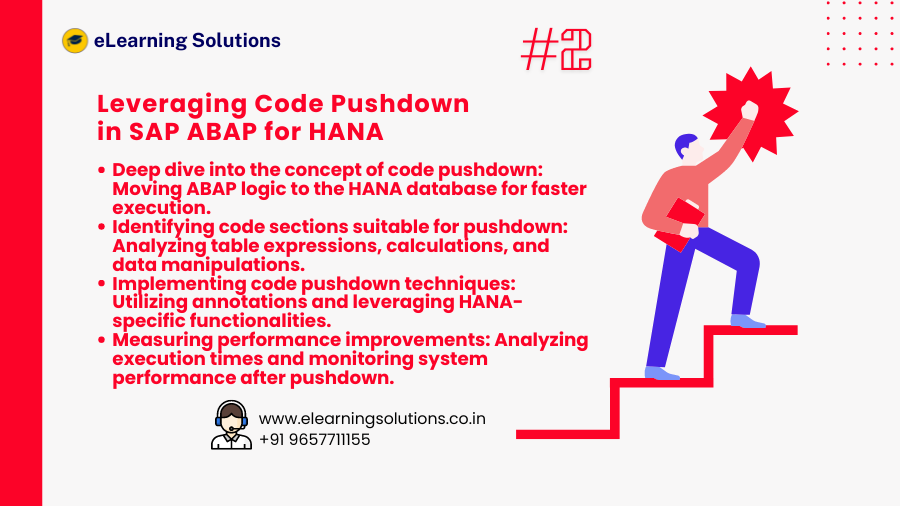Unleashing Speed: Leveraging Code Pushdown in SAP ABAP for HANA – Part 2
Part 1 of this series introduced the exciting world of SAP ABAP for HANA, highlighting the paradigm shift towards data-centric development. One of the most impactful features in this realm is code pushdown. In this blog, we’ll delve deeper into code pushdown, exploring its mechanics, implementation techniques, and the benefits it offers for performance enhancement.
Code Pushdown Demystified: Bringing ABAP Logic to HANA
Traditionally, ABAP applications executed logic within the application server, fetching data from the database, performing calculations, and returning the results. Code pushdown breaks this pattern. It allows you to move specific portions of your ABAP code directly to the HANA database for execution. This approach leverages HANA’s in-memory processing power, significantly reducing data transfer between the application server and the database. The result? A dramatic improvement in application performance.
Identifying Code Pushdown Candidates: Where Does It Shine?
Not all ABAP code sections are ideal for pushdown. Here’s where to focus your efforts:
- Table Expressions: Complex calculations involving joins, aggregations, and filtering operations within table expressions are prime candidates for pushdown. HANA excels at handling these operations in-memory, leading to faster processing.
- Calculations and Data Manipulations: If your ABAP code performs extensive calculations or data manipulations on retrieved data, pushing this logic down to HANA can significantly improve performance.
- Data Filtering and Sorting: Filtering and sorting large datasets within ABAP code can be time-consuming. By pushing these operations to HANA, you leverage its optimized algorithms for faster filtering and sorting.
Implementing Code Pushdown: Putting Theory into Practice
There are two primary ways to implement code pushdown in ABAP for HANA:
- Annotations: SAP provides annotations that you can embed within your ABAP code to mark specific sections for pushdown execution within HANA.
- HANA-Specific Functionalities: Utilize built-in HANA functionalities like analytical views and procedures within your ABAP code. These functionalities are specifically designed for efficient in-memory processing.
Measuring the Impact: Quantifying Performance Gains
The true value of pushdown lies in its tangible performance improvements. Here’s how to measure the impact:
- ABAP Performance Trace (STAT): Use the STAT statement within your ABAP code to analyze execution times before and after implementing pushdown. This helps you quantify the performance gains achieved.
- System Monitoring Tools: Leverage SAP HANA Studio or other system monitoring tools to track overall application performance after pushdown implementation. Look for reductions in response times and improved system resource utilization.
A Word of Caution: Not a One-Size-Fits-All Solution
While pushdown offers significant benefits, it’s important to exercise caution. Here’s why:
- Complexity: Pushing down complex logic might require restructuring your ABAP code.
- Maintainability: Code residing within the database might be less maintainable compared to traditional ABAP code.
- Debugging: Debugging code pushed down to HANA can be more challenging.
Conclusion
Code pushdown is a powerful tool in the ABAP for HANA developer’s arsenal. By strategically identifying suitable code sections and implementing pushdown techniques, you can unlock significant performance improvements for your SAP applications. However, remember to weigh the benefits against the potential complexity and consider the maintainability of your codebase.
Stay tuned for Part 3 of this series, where we’ll explore other essential features of ABAP for HANA development, such as Core Data Services (CDS) and ABAP Managed Database Procedures (AMDP)!



 WhatsApp us
WhatsApp us